KODAK DCS 460 DIGITAL CAMERA
The BIG picture
by John Henshall
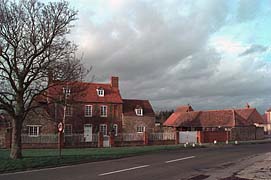
Stanford in the Vale, Oxfordshire, England, with
EPIcentre's future home on the right of the picture.
We bring you the world's highest resolution single
shot colour images from a truly portable digital camera.
Kodak have had the field of professional single shot digital cameras to themselves for almost four years. In that time they have introduced four cameras, each outstanding in its own way. Research and development costs must have been huge but so should be the rewards. Not in profits, yet, perhaps, but in the experience and feedback which jumping in at the deep end has brought.
To succeed, digital cameras must make a photographer feel at ease and help him become more productive. At the outset, Kodak made the decision to attach all their digital camera technology to an existing camera body. This was an excellent idea which minimised techo-fear. Kodak also made another important decision: not to tether their digital cameras to tripods and computers. Photography is about being free, able to roam at will to capture living subjects.
But Kodak no longer have the field to themselves. Leaf now have a single shot camera, the Catchlight, and see in-store social photography as one of its major applications. Kodak's exclusive use of Nikon camera bodies has led to Kodak digital cameras often being referred to as 'the digital Nikons', yet Nikon have teamed up with Fuji for their upcoming digital camera, not with Kodak. Maybe this was the catalyst which persuaded Kodak to link with Canon to produce two more forthcoming cameras?
What we now see from Kodak are two major new cameras, the DCS460 and the DCS465. Both use a huge six megapixel chip. The DCS460 is, once again, based on a Nikon - the F90. But the DCS465 is more like 'digital film', for it is not dedicated to just one camera.
In place of film, digital cameras use CCD chips to capture images
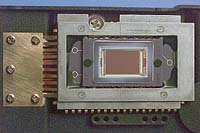
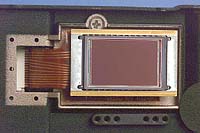
Left: The DCS420 area array chip has 1012 x 1524 pixels - a total of 1,542,288 - in a 9.5 x 14mm area. The DCS420 is priced at just over £8,000.
Right: The DCS460's 'M6' CCD has 2036 x3060 pixels - a staggering total of 6,230,160 - on a chip four times as big as that in the DCS420. This makes the DCS460 the highest resolution single-shot colour digital camera in the world. Although still not the full 24 x 36mm frame of 35mm film, the 19 x 28mm array almost fills the film plane and - for the first time - allows the use of true wideangle and even fisheye lenses on a Kodak digital camera.
The standard Nikkor camera lenses used with these cameras produce a full 24 x 36mm image, the unused light from which will bounce off the bright metal parts which surround the chips in the focal plane. It would be good practice to paint these matte black to minimise flare caused by scatter inside the camera body. At £25,000 the DCS460 costs three times as much as the DCS420.
My images? They had to be taken in a hurry. But the DCS460 is about being able to grab high quality images quickly. The chip has six million individual sampling points, all of which are captured in a split second. It's like laying a very fine wire mesh over the scene and writing down the colour and brightness values seen through each one. Instantly. Phenomenal.
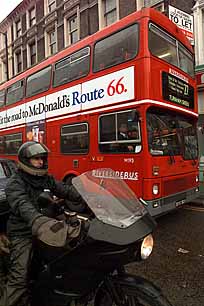

Hammersmith Road, West London, on a cold rainy day in January.
Production models of the DCS460 will be rated ISO80 but this picture was taken at 1/30 second at 3.5 - wide open on a 15mm lens - with the camera rated at ISO200.
(Enlarged section displayed at 1 : 1 - one pixel to one monitor element)
Because of the large size of the image files there is a twelve second delay between taking shots, while waiting for the image to be saved to the removable 105Mb PCMCIA miniature hard disc drive, which holds sixteen images.
Each image took three and a half minutes to acquire and interpolate from the camera - a painful wait if you have a number of images to acquire in a session. But knowing one of the Kodak design team in Rochester brought me the very latest acquire software by modem from the USA. This reduced the acquire and interpolation time immediately to - wait for it - forty seven seconds. Yes, that's over four times quicker. The latest software also has a nice film-like roll-off at the top and bottom of the curve, resulting in less blue noise. A forthcoming new dichroic filter will improve noise in the blue channel (a major criticism of digital camera pictures to date) by a factor of two or three and enable cameras to shoot in tungsten light.
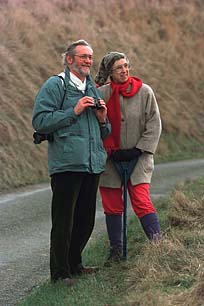
Peter and Fran Hodges survey the view from White Horse Hill.
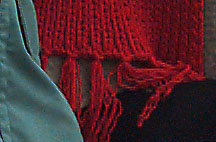
Detail from Fran's scarf in the above shot.
(Displayed here at 1 : 1 - one pixel to one monitor element)
The cameras used for the accompanying shots were pre-production models, from which I had already acquired the images before receiving the new software. When judging the images, please bear in mind that, with the new software, images acquired from these same cameras should now be improved. And production models will be available with twice the DRAM, enabling them to acquire two images in rapid succession. The DCS460 brings the inevitable day when all images are created digitally.
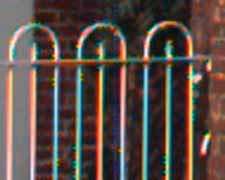
A greatly enlarged section of the railing between the front door and gate in the picture at the top of this page. One of the most difficult subjects for this kind of digital camera to interpolate.
I am grateful to Joanne Palmer at Kodak in Hemel Hempstead for making the DCS460 available for my presentations both at Ray Hammond's Digital Images '95 and Future Communications - Spring Into Repro. Both have been major conferences with large numbers of delegates. Thanks are also due to Kodak's Phil Fennessy. As soon as it is possible to clone him in Photoshop I'll do that as a favour for Kodak: they need more with his skills. Also thanks to a certain boffin in Rochester whom I know you'd love me to name but I'd better not, in case he's inundated with calls.
This review first appeared as "John Henshall's Chip Shop" in "The Photographer" March 1995.
IMPORTANT NOTICE
This document is Copyright © 1996 John Henshall. All rights reserved.
This material may only be downloaded for personal non-commercial use. Please safeguard the future of online publishing by respecting this copyright and the rights of all other authors of material on the Internet.










